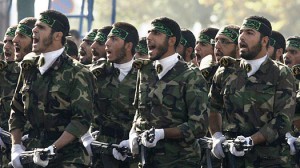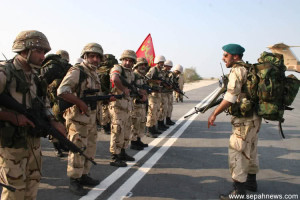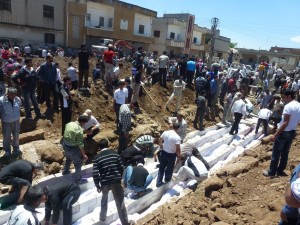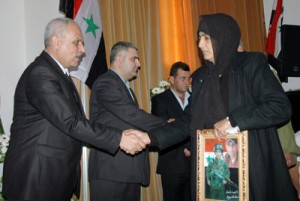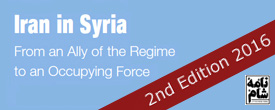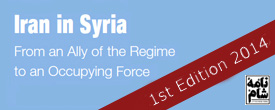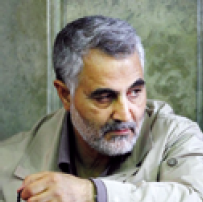 Contents of this section:
Contents of this section:
Creating the shabbiha
The Iranian connection
Training
War crimes and crimes against humanity
Case study: The Houla and Bayda massacres
Case study: The shabbiha in Homs
Notes & References
Update: Restructuring the NDF and forming ‘Hezbollah Syria’
1. Sepah Pasdaran ‘advisors’
As mass anti-regime protests started to spread across Syria in the spring of 2011, the Syrian regime’s leadership decided to create a paramilitary force charged with attacking and terrorising protesters in an attempt to quell them. The goal was to form an ‘effective’ and locally based force of pro-regime militias that were more loyal and more reliable than regular army conscripts, many of whom would indeed desert the army later and join the Free Syrian Army (FSA).
Initially known as the Popular Committees, the force later became officially known as the National Defence Forces (NDF), which comprised at least 70,000 men and women as of mid-2014. Although commonly referred to by most Syrians as ‘shabbiha’, the two are slightly different in that NDF members receive regular salaries and military equipment from the regime, while ‘normal’ shabbiha reportedly only receive a few hundred Syrian pounds as ‘rewards’.
The term shabbiha, which is derived from the Arabic word for ghost (shabah), originally referred to shadowy smugglers and racketeers, operating mostly in the coastal province of Latakia.3 In 2011, these gangsters, along with other criminals released from prison, mercenaries and Ba’athist volunteers, were converted into a militia.
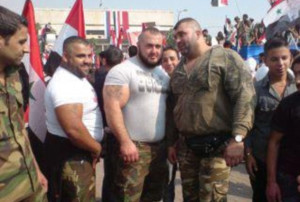
Syrian shabbiha (date unknown)
Creating the shabbiha
In March 2014, the British newspaper The Telegraph published an interview 4 with a former member of the Assad family’s inner circle on how the shabbiha forces were created. Abdul Salam, a pseudonym for a former business partner of Rami Makhlouf, the Syrian president’s cousin who controls a huge business empire in Syria, described how he and seven other ‘allies’ from around the country were invited to secret meetings in Damascus in Summer 2011, in which Makhlouf and Maher al-Assad, the president’s brother who commands the elite fourth armoured division of the military, planned “the making of the shabiha” to do the “dirty work” of the regime to counter the anti-regime protests.
“They told us they were worried that the army, in front of the world’s media, couldn’t use the necessary force to stop the protests,” he said. “They couldn’t be seen to be shooting the protesters. So their idea was: ‘Let’s keep our hands clean and create a paramilitary group to do the dirty work’.” Their plan included appointing leaders for local militia forces across the country; releasing death-row prisoners held in Homs and Tartous jails to join the force; and providing them with money and weapons. “They told us to kill protesters, armed or unarmed, and torture those you capture,” he added.
Abdul Salam describes Rami Makhlouf and Maher al-Assad as “the brains behind the shabbiha operation” and says they were the ones who provided the money and arms. But later revelations would show this story to be incomplete, as discussed in the next section.
Various other testimonies seem to confirm Abdul Salam’s account of how and why the NDF was created. For example, in April 2013, Reuters quoted a Syrian military commander from Damascus saying: “After the events began, our leadership started to lose faith in the army and its effectiveness on the ground in a war like this… So we got the idea to make the National Defence Forces. They started out as popular committees patrolling their neighborhoods. Then they became armed groups. And in late 2012, they were legitimized under the name National Defence Forces (NDF).”5
Another article published in The Wall Street Journal in August 2013 tells a similar story: “The genesis of the Defense Force goes back to [summer 2012] when the regime hastily organized so-called popular committees among loyalist communities in Damascus to help fend off a major rebel offensive in the capital… By the fall, the Syrian regime had decided to create a national force similar to the Basij – the paramilitary group created by Iran’s clerical regime in the 1980s to fight in the Iran-Iraq war – government officials said at the time.”6
It is worth noting that shabbiha members are not only Alawis, as they are often portrayed in Western media reports. They also include Sunnis, Druze and other ethnic and religious backgrounds depending on the region. In Aleppo, for example, many shabbiha come from powerful local families, the most notorious of which being the Berri family, which is known for drugs and arms smuggling and its close ties to the regime. In Rukin al-Deen in Damascus, many belong to Damascene-Kurdish families; in Deir al-Zor, to Arab Sunni families and clans… and so on and so forth.7
The Iranian connection
These and other testimonies seem to omit one crucial element: the role of the Iranian regime in creating the shabbiha force. It may be that, at the time, little was known about the Iranian regime’s role in Syria. But this is no longer the case.
Almost three years after the NDF was first thought of, a high-ranking Iranian general admitted that Sepah Pasdaran had played an important role in setting it up. During a speech in April 2014, Brigadier-General Gholam Ali Rashid, the Deputy Head of the General Staff of Iran’s Armed Forces, reiterated the Iranian regime’s official line that “we are not fighting in Syria” but admitted “advising the commanders who formed the National Defence Force,” which he described as “organisationally similar to Basij.”8
The Basij, officially known as the Organisation for Mobilisation of the Oppressed, is an Iranian paramilitary militia established by Ayatollah Khomeini in 1979 and is often used by the Iranian regime to terrorise and suppress protests and dissident movements in Iran, such as the so-called Green Movement in 2009.
About a month after Rashid’s admission, another senior Iranian commander boasted of establishing a “second Hezbollah” in Syria, in reference to the NDF, which he claimed comprised some 70,000 young Alawi, Shia and Sunni fighters organised in 42 groups and 128 battalions.9
Around the same time, another prominent Iranian official, Hojjat al-Islam Mehdi Taeb, the head of Ayatollah Khamenei’s think-tank, Ammar Strategic Base, made similar remarks: “Syria had an army, but did not have the ability to manage a war inside Syria’s cities. It is for this reason the Iranian government suggested that ‘in order to manage an urban war you must form a Basij… The Syrian Basij was formed with 60,000 [members] of the Party of God [religious zealous] who took over the war in the streets from the army.”10
Coupled with the above-mentioned testimonies, these three admissions are crucial pieces of evidence regarding the Iranian regime’s role in creating the NDF, and therefore its complicity in the crimes committed by NDF members. The fact that the force was modelled on the Iranian Basij suggests that there was more to the Iranian role than general advice; Iranian commanders helped their Syrian counterparts organise the force. In the words of Victoria Nuland, a US State Department spokeswoman, “The Iranians have clearly supplied support and training and advice to the Syrian army, but this Shabbiha thug force mirrors the same force that the Iranians use. The Basij and the Shabbiha are the same type of thing and clearly reflect the tactics and the techniques that the Iranians use for their own suppression of civil rights.”11
A 2013 study by the Institute for the Study of War and the American Enterprise Institute’s Critical Threats Project, entitled Iranian Strategy in Syria, claims that Sepah Pasdaran’s Qods Force and elements of the conventional Sepah Pasdaran Ground Forces, as well as several Iranian intelligence agencies, formed a “top-level advisory mission” to support the Syrian regime since early 2011.12 Although the two think-tanks that produced the report are known for their close ties with US ‘hawks’ and neoconservatives, the report’s authors provide a great deal of credible information and back up their claims with verifiable sources.
Among these sources are the periodical sanction designations produced by the US Treasury Department. One of these designations, released in June 2011, claimed that the deputy chief of Iran’s Law Enforcement Forces (LEF), Ahmad-Reza Radan, travelled to Damascus in April 2011, where he “met with Syrian security services and provided expertise to aid in the Syrian government’s crackdown on the Syrian people.”13 Another report, from September 2012, claimed that Brigadier-General Hossein Hamedani, the former commander of the Greater Tehran unit in Sepah Pasdaran who led the 2009 crackdown on the Green Movement protesters in Tehran, was leading this ‘advisory mission’.14 We will have more to say about Hamedani and his colleague Gen. Qassem Soleimani later in the report.
According to a former senior Iranian official “with close links to Sepah Pasdaran,” in February 2014 there were “a few hundred” commanders from Sepah Pasdaran and Sepah Qods in Syria.15 A recently retired senior Sepah Pasdaran commander also told Reuters that “top” Sepah Qods commanders in Syria numbered between 60 to 70 at any given time.16 Their role, according to these sources, was to “direct and train Syrian forces”, “assist in the gathering of intelligence” and “direct the fighting on the instructions of the Qods Force commanders.” While many lower-ranking officers went in and out of Syria by land though Turkey and Iraq, the senior commanders were reportedly flown directly to and from Damascus. Many apparently did not carry Iranian passports but Syrian ID cards and wore Syrian military uniforms.17
For over a year after the outbreak of the revolution, Iranian officials kept denying any involvement in Syria. In May 2012, however, in one of the first official admissions of its kind, the deputy chief of Sepah Qods, Ismail Qani, said in an interview with the Iranian Students News Agency (ISNA): “If the Islamic Republic was not present in Syria, the massacre of people would have happened on a much larger scale… Before our presence in Syria, too many people were killed by the opposition but with the physical and non-physical presence of the Islamic Republic, big massacres in Syria were prevented.”18 (emphasis added)

Sepah Psadaran’s chief: “Sepah is offering [Syria] assistance in planning, as well as financial help, but does not have a military presence [in Syria].”
Training
But, of course, it was never just advice and consultancy. At the above-mentioned news conference, Jafari also mentioned a 50,000-strong militia of ‘volunteers’ called al-Jaysh al-Shaabi, or The Popular Army, another old name that was sometimes used for the NDF. “Currently, 50,000 people are being prepared and trained,” he added. “It is an honor for the Islamic Republic of Iran to share its experience and provide any kind of consultation to help defend Syria.”20
Back in May 2011, the US Department of Treasury had announced the designation of ten Syrian and Iranian individuals and entities targeted with sanctions for their involvement in human rights abuses, including the repression of Syrian people. Among them, and alongside Qassem Soleimani, was Mohsen Shizari, whom the US Treasury describes as a “senior [Sepah Qods] officer who serves as the [force’s] Commander of Operations and Training”.21
The US Treasury does not provide details of why Shizari was added to its sanctions list but it is safe to assume that it had to do with his role in directing Sepah Qods’ training efforts in Syria, as his title suggests. Note also the early date of this designation: 18 May 2011, barely two months after the outbreak of the revolution and well before it was pushed into militarisation.
The US Treasury has also sanctioned Iranian airlines, such as Mahan Air, for providing “travel services for [Sepah Qods] personnel flown to and from Iran and Syria for military training,” in addition to “secretly ferrying operatives, weapons and funds on its flights.”22
Other pieces of evidence about the Iranian regime’s role in training Syrian regime forces include leaked videos and reports of Syrian regime commanders referring to such a role. In one video, a Brigadier-General from the elite Syrian Republican Guards is addressing his troops in the aftermath of the siege and destruction of the Baba Amr district in Homs in Spring 2012.23 Throughout the video, the soldiers are heard shouting pro-Assad slogans, including “Shabbiha forever, we are your soldiers, O Assad.” At 07:10, the general is heard saying: “I have some things to tell you. We are now forming the 416th Battalion of commandos for special missions, and they are being trained by trainers from inside and outside the country.”
Again, the general does not specify who these foreign trainers are, nor where the training is taking place. But it is safe to assume that they were Iranian, as there is no evidence to suggest that any other country has provided such a service to the Syrian regime. The Special Forces training has traditionally taken place at a complex in al-Dreij, near Damascus.
In April 2013, the Free Army’s Shuhadaa Idlib Brigade captured an Iranian trainer in the suburbs of Idlib. In a video posted online, the captive says in broken Arabic that he had been in Syria for five months training pro-regime snipers.24 What is alleged to be his identification documents are also displayed. In a televised interview a few days before, the commander of the brigade, who interrogates the Iranian captive in the video, claims they had also killed another Iranian fighter, whose documents are shown on camera.25
Iranian military trainer captured by Syrian rebels in Idlib in April 2013.
One relevant question here is whether these foreign trainers were only training regular army soldiers or irregular paramilitary forces too. There is enough, concrete evidence of the first, and it can be seen as a continuation of ‘normal’ international relations under long-standing military cooperation agreements between Syria and Iran. For example, in February 2012, two Iranian Navy ships docked at the Syrian port of Tartus, having sailed through Egypt’s Suez Canal. This was the second time that an Iranian naval fleet passed through the canal since 1979. According to Iranian state-controlled media, the aim of this high-profile mission was “to provide maritime training to naval forces of Syria under an agreement signed between Tehran and Damascus a year ago.”26
But what about training the shabbiha? A rare news report in a local Syrian opposition news site from July 2013 claims that, not very far from the above-mentioned Special Forces complex in al-Dreij, a new, closed training camp for the NDF had been established.27 Two people on average are selected from each area of Syria (the report focuses on al-Swaidaa in the south) and sent there to undergo a special training course, after which they ‘qualify’ to lead local militia forces and receive a monthly salary of 15,000 to 25,000 Syrian pounds. Four of the al-Swaidaa trainees had been identified by the reporters and their families had been contacted in an attempt to dissuade them from “taking this step.”
The report – which is primarily about another training course for Political Security personnel administered by Hezbollah Lebanon trainers, three of whom are named in the report – appears to be authentic and credible but cannot be independently verified. Neither can be occasional reports of opposition forces launching attacks on what they describe as shabbiha training camps, particularly in the coastal region and in the suburbs of Damascus and Homs.28
Another alleged location for training the shabbiha, particularly a division called the Capital’s Streets Protection Force, is said to be the compound of the Political Security branch in al-Mezzeh in south-western Damascus, not far from the Mezzeh military airport and Hezbollah Lebanon’s Damascus headquarters.29 But whether Iranian trainers and advisors are based at these locations is difficult to confirm.
The most direct evidence of Iranian involvement in training the shabbiha comes from rare revelations by Iranian officials. In February 2014, Iranian MP Seyyed Mahmoud Nabavian boasted during a speech that Iran had trained some 150,000 Syrian regime fighters on Iranian soil, and another 150,000 in Syria, in addition to 50,000 Hezbollah Lebanon fighters.30 These 300,000 Syrian fighters cannot have all been regular army soldiers, whose training was organised by the Ministry of Defence. Other available information on who is fighting and who is undergoing military training does not seem to support such a conclusion.
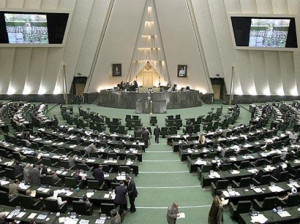
Iranian MP Seyyed Mahmoud Nabavian: “Iran trained 150,000 Syrian regime fighters on Iranian soil, and another 150,000 in Syria.” February 2014.
The revelation caused a storm in Iran, suggesting it may have been true. One MP demanded that Nabavian should be prosecuted, adding that disclosing such details paints Iran as a “supporter of terrorists” and would harm the country’s “national interests.”31 But Mansour Haghighatpour, who is affiliated with the ruling conservative block, did not deny the Iranian regime’s role in training and supporting Basshar al-Assad’s forces; he only said that revealing such details would harm Iran’s ‘national interests’ and should therefore be kept secret.
In April 2013, Reuters interviewed four Syrian regime fighters who claimed they had been on an “urban warfare course” at a “secret base in Iran.”32 They were all flown from an air base in Latakia to Tehran International Airport, then put on buses, whose windows were covered by curtains, and driven to an undisclosed location about an hour and a half drive from the airport.
The interviewees were all militiamen from minority backgrounds; they were not regular army soldiers. One of them is quoted saying their Iranian trainers told them the course, which lasted 15 days, was “the same course that Hezbollah operatives normally do.” Other interviewees said volunteers would assemble in groups of around 400 before being flown to Iran in smaller numbers, while others were trained by Iranians inside Syria.
In September 2013, The Wall Street Journal (WSJ) published a similar investigation about a base near Tehran, where Iranian forces were training Shiite militiamen from across the Arab world to go and fight in Syria.33 In addition to fighters and local residents, the WSJ had interviewed an Iranian military officer briefed on the training camp, which is said to be 15 miles outside Tehran and called Amir al-Momenin, or Commander of the Faithful (a traditional title for Muslim Caliphs). Amir al-Momenin is a famous Sepah Pasdaran military base and is home to the force’s ballistic missiles arsenal, among other things.34
In another report from August 2013, members of the National Defence Forces told the WSJ they had received “boot camp and more advanced combat training in Syria from Hezbollah operatives or have been flown to Iran for similar purposes.”35 Hezbollah confirmed providing such training, while a spokesman for Iran’s mission to the United Nations declined to comment, according to the paper.
The most conclusive evidence of the Iranian regime’s involvement in training Syrian regime militias is perhaps a video broadcast by the Netherlands Public Broadcasting network (NPO) and other media outlets around the world in September 2013.36 It was shot by an embedded Iranian cameraman who died in battle in Syria shortly after he filmed this footage in August that year. Syrian rebels (the Dawood Brigade) obtained the footage after overrunning a group of Iraqi and Iranian fighters from Abu al-Fadl al-Abbas Brigade and handed it to Dutch Journalist Roozbeh Kaboly.
The video shows members of a Sepah Pasdaran unit living in a school in a village near Aleppo and meeting with local Syrian regime commanders and fighters, with whom they say they have “good relations.” A Sepah commander tells the camera he had been, for over a year, “working with Syrian militias,” many of whose members “had been previously trained by us in Iran.” Another NPO report, a few days before, showed other parts of the footage showing Syrian regime troops receiving instructions from Iranian commanders.37
Around that same time, Iranian media reported the death of the commander who appears in the above-mentioned footage. Ismail Haydari was reportedly killed in battle near Damascus. Most Iranian state-controlled media reports claimed he was a ‘filmmaker’ and was in Syria to make a documentary, lumping his story with that of the Iranian filmmaker, Hadi Baghbani, who shot the footage and who died in Syria at or around the same time (on 20 August 2013).38 However, pictures of Haydari’s mass funeral published by some Iranian sites clearly show a military-style funeral, where many Sepah Pasdaran officers in military uniform are seen saluting the coffin.39 Haydari is also described in some of these reports as a Sardar, a military rank in Persian equivalent to Field Marshal. It is likely that Haydari was the subject of Baghbani’s special documentary (more on this below, in the ‘Iranian Fighters’ section).
Footage captured by Syrian rebels in August 2013 shows Iranian commander Ismail Haydari talking about ‘working with’ Syrian militias in Aleppo.
It is worth pointing out that creating and training the Syrian shabbiha on suppressing protests and dissidents may have also provided Sepah Pasdaran itself with valuable experience. In October 2011, Sepah announced the creation of a new force of 31,000 members called the Imam Ali Security Battalion, whose task is to “defend the [Islamic] revolution and absorb people[‘s anger].”40 In his inauguration speech, the chief of Sepah Pasdaran Mohammad Ali Jafari said: “Our task in not limited to physically [responding to] the events. We have to realize how to counter those people who have attended such scenes [protests].” “The nature of the threats is changing,” he added. “It is the art of Sepah and Basij to match itself to the changes and to realize the threats which are aimed at the future of the revolution.”
War crimes and crimes against humanity
Over the past three years, the Iranian-trained shabbiha have “reigned with violence and impunity,” as the Telegraph interview mentioned above puts it. There have been numerous reports about shabbiha members looting houses and setting them on fire; about them destroying entire villages and raping, torturing and slitting the throats of inhabitants suspected of opposing the regime. The shabbiha are also often charged with finding, torturing or killing anti-regime activists. They now have their own detention centres and torture facilities across the country. Their presence and checkpoints are often feared by Syrians more than those of the regular army due to their infamous brutality.
The shabbiha have come to be particularly associated with two types of ‘routine crimes’: looting and rape. Unlike army soldiers, NDF fighters are allowed, and even encouraged, to loot houses and take ‘spoils’ after battles, which they then sell on the black market in regime-held areas or in Lebanon. In fact, this has been used by the regime as an incentive to recruit for the NDF. A number of captured shabbiha members have admitted to this. For example, in April 2013, an NDF fighter from Homs told Reurters: “I get 15,000 lira ($158) a month, and I am allowed to keep a percentage of the loot from any battle I fight in.”41
Similarly, many NDF fighters have admitted, and even bragged about, raping the ‘enemy’s women’, in what appears to be a systematic practice. In July 2012, a captured shabbiha member admitted receiving 30,000 Syrian pounds per month and an extra 10,000 for each person he captured or killed. He also admitted raping one woman, a student at Aleppo University, before killing her. “My commander raped many times,” he added. “It was normal.” As to the reason, he had this to say: “I didn’t care about Bashar al-Assad. All I cared about was that I got the power.”42
At the beginning of the revolution, in Spring 2011, the role of the shabbiha was limited to beating and shooting protesters. Gradually, as they became more organised and better trained and armed – thanks to Sepah Pasdaran and Hezbollah Lebanon – they started to join the regime’s armed forces in major military campaigns against various towns and cities around the country, and even organise their own campaigns of terror. In April 2013, a Syrian army officer in Homs told Reuters that the army was “increasingly playing a logistical and directive role, while NDF fighters act as combatants on the ground.”43
Case study: The Houla and Bayda massacres
The most well-known and well-documented massacre committed by the shabbiha is perhaps the massacre of Houla, north of Homs, in May 2012. Almost 100 civilians, nearly half of them children, were executed by shabbiha armed men.44 Survivors described how gunmen entered their homes, fired indiscriminately and slit the throats of men, women and children.45
The UN Independent International Commission of Inquiry subsequently released a 102-page report 46 accusing the shabbiha fighters who carried out the Houla summary executions of “committing the crimes against humanity of murder and torture, war crimes and gross violations of international human rights and humanitarian law, including unlawful killing, indiscriminate attacks against civilian populations and acts of sexual violence.” Furthermore, the report said that these crimes were committed “pursuant to state policy,” pointing the finger at the “highest levels of the Syrian armed and security forces.”
Other famous massacres committed by the shabbiha include the al-Bayda and Banyas massacres in May 2013, where army and shabbiha forces rounded up and executed at least 248 civilians, including women and children, after clashes had ended and opposition fighters had retreated. In September 2013, Human Rights Watch published a 68-page report summarising its investigation into the massacre, based on witness accounts and video evidence.47 The report described the massacre as “one of the deadliest instances of mass summary executions since the start of the conflict in Syria.”48
Case study: The shabbiha in Homs
A particularly notorious shabbiha force has reportedly been that of Homs. Various leaked internal documents and testimonies reveal a world of violence, crime and mafia-style networks that do not appear to have any guiding values or principles other than money and power.49
In one document, leaked in February 2014 to an independent Syrian opposition newspaper,50 a letter submitted by an anonymous resident of Homs to the Presidential Palace details what it describes as the “non-patriotic” practices of the local NDF in the city, which the document describes as “worse than the practices of the terrorists” and even equates them to “systematic war crimes.” The letter names a number of local militia leaders but focuses mainly on the force’s chief in Homs, Saqr Rustum, who it claims is personally in charge of a special unit within the force responsible for “special missions” such as assassinations, kidnappings, robbery and so on.
The document gives detailed and well-informed examples of these ‘non-patriotic’ practices, including selling weapons and ammunition to armed opposition forces for extortionate prices; the bombing of a NDF arms depot in the Wadi al-Dahab district in August 2013 to avoid an inspection that would have revealed stolen and sold-off weapons and ammunition; and even smuggling in and detonating car bombs in regime-loyalist areas to send a message to the leadership in Damascus that “the Military Security is incapable of controlling its check point so it should be taken from it and handed over to the NDF.”
The letter also reveals that up to 8,500 of the 18,500 NDF members in Homs are in fact inactive. They are only NDF members on paper because they wanted to avoid the compulsory military service. Saqr Rustum, the document claims, submits their names to the General Staff Command as having joined the NDF so they do not have to do the military service, in exchange for keeping their salaries (25,000 Syrian pounds a month) for himself.
Other criminal practices mentioned in the document include robbing people and vehicles at checkpoints and kidnapping men and women to blackmail their families for ransom. Other reports based on insider testimonies have also talked about this practice (the kidnapping of civilians, including women, in regime-held areas, especially among the Alawite and Christian communities).51 Pro-regime media have often accused the ‘sectarian terrorists’ of the opposition armed forces for such incidents.
Following an increasing number of complaints and demonstrations by residents in Homs about these practices, the governor of Homs, in collaboration with the military security, arrested 330 NDF members in January 2014. In retaliation, the NDF attempted to assassinate the governor by firing mortars on his house, according to the letter.
Significantly, the document blames the regular army for these criminal practices, which it says are “very widespread” and “have gone too far.” That is because the army has been handing over entire areas to the NDF after finishing its operations there. This scenario, the letter adds, is repeated in all the areas that fall under the control of regime forces. The NDF would then surround the area, set up checkpoints, and the ‘special missions unit’ would then comb the area and rob houses of everything they can put their hands on, then load the ‘spoils’ into trucks and take them to be sold elsewhere.
These reports should not be surprising given the composition of the NDF, whose members include many convicted criminals who were released from prison at the start of the revolution to form the force, not to mention the original shabbiha racketeers and gangsters. For example, Saqr Rustum, the leader of the NDF in Homs, was a civil engineer who occupied the position of the vice-president of the Hasyaa industrial zone in Homs, but was fired after it was found out that he had been involved in large-scale corruption. A few months after the outbreak of the mass protests in Homs, his maternal uncle, a brigadier-general who served as a military advisor to president Bashar al-Assad, put him in charge of forming a local pro-regime militia (or Popular Committee, as it was known then) in Homs.52
There has not been much concrete evidence of a direct link between the Homs shabbiha and Iranian commanders, but it is safe to assume that such a link does exist, especially given the strategic importance of Homs to the Iranian regime and Hezbollah Lebanon and their presence and activity in the city and the surrounding areas since mid-2012, which will be discussed in detail in the next section.
Unfortunately, none of these reports documenting the crimes committed by the shabbiha and the NDF point out the Iranian connection. When Iranian officials kept repeating, throughout the first two years of the revolution, that they were only present in Syria as ‘advisors’ – as a way to deny direct military involvement – what that meant was advising, among other things, on setting up, training and arming one of the most notorious militia forces that has been responsible for war crimes and crimes against humanity committed in Syria. As a US Treasury sanctions designation from December 2012 put it,
“Iran has helped establish and train the Jaysh al-Sha’bi militia in Syria [another early name for the NDF] to support the Assad regime and relieve pressure on Syrian government forces. Since mid-2012, Iran’s Islamic Revolutionary Guard Corps-Qods Force (IRGC-QF) and Hezballah have provided training, advice, and weapons and equipment for Jaysh al-Sha’bi. Iran has also provided routine funding worth millions of dollars to the militia.”53
We now know that Major-Gen. Soleimani, the commander-in-chief of Sepah Qods and Ayatollah Ali Khamenei’s man in Syria, deployed top Sepah commanders to Syria to help the Assad regime suppress the mass popular protests. Among these were experienced Sepah commanders who had supervised counter-insurgency campaigns against Iran’s own anti-regime movements, as well as the brutal crackdown on Iranian pro-democracy protests in 2009 known as the Green Movement. Among them were Gen. Hossein Hamedani, Yadollah Javani, Mohsen Shizari, Ismail Haydari and others. All these commanders, along with their superiors (Soleimani and Khamenei), should also be implicated in the crimes committed by the shabbiha and the NDF, because evidence suggests it was with their full knowledge and complicity, if not their direct orders, that these crimes were committed. The continuation of Iranian training, advice and financial and military support to these militia forces, even after some of these crimes came to light, only goes to prove such complicity.
Notes & References
3 For a brief history and insight into the inner workings of the shabbiha, see: ‘Who are the shabbiha?’ (in Arabic). See also this Telegraph article: ‘The Shabiha: Inside Assad’s death squads’, 2 June 2012.
4 Salwa Amor, Ruth Sherlock, ‘How Bashar al-Assad created the feared shabiha militia: an insider speaks’, The Telegraph, 23 Mar 2014.
5 Erika Solomon, ‘Insight: Battered by war, Syrian army creates its own replacement’, Reuters, 21 April 2013.
6 Sam Dagher, ‘Syria’s Alawite Force Turned Tide for Assad’, The Wall Street Journal, 26 August 2013.
7 For more on this, see for example: Yassin al-Haj Saleh, ‘On the shabbiha and tashbeeh and their state’ (in Arabic), Kalamon 5, Winter 2012. An English translation is available here.
8 Brigadier-General Rashid’s admission was made during a speech in Dezful, Khuzestan at an official commemoration of the city’s liberation from Iraqi forces in 1982. The speech was reported by the Dezful Emrooz news website in Persian. For an English translation and commentary, see here.
9 Brig. Gen. Hossein Hamedani’s comments were reported by Iranian state-controlled news agency Fars News on 4 May 2014, but the report was later removed from the agency’s website. A screen shot and an English summary of the report are available here.
10 ‘Head of Ammar Base: Our priority is to keep Syria rather than Khuzestan’, BBC Persian, 14 February 2013. For an English translation, see: ‘Head of Ammar Strategic Base: Syria is Iran’s 35th Province; if we lose Syria we cannot keep Tehran’, Iran Pulse, 14 February 2013.
11 Chris McGreal, ‘Houla massacre: US accuses Iran of ‘bragging’ about its military aid to Syria’, The Guardian, 29 May 2012.
12 Fulton, Joseph Holliday and Sam Wyer, Iranian Strategy in Syria, AEI’s Critical Threats Project and Institute for the Study of War, May 2013.
13 US Department of Treasury, ‘Treasury Sanctions Syrian, Iranian Security Forces for Involvement in Syrian Crackdown’, 29 June 2011.
14 Farnaz Fassihi and Jay Solomon, ‘Top Iranian Official Acknowledges Syria Role’, The Wall Street Journal, 16 September 2012.
15 Jonathan Saul and Parisa Hafezi, ‘Iran boosts military support in Syria to bolster Assad’, Reuters, 21 February 2014.
16 Ibid.
17 Ibid.
18 Saeed Kamali Dehghan, ‘Syrian army being aided by Iranian forces’, The Guardian, 28 May 2012.
19 ’Sepah chief confirms presence of Sepah Qods members in Syria’ (in Persian), Radio Farda, 16 September 2012. A summary in English is available here.
20 ‘Shahed 129’’ drones capable of launching missiles have been maufactured – US bases in Sepah’s gun reach’ (in Persian), Fars News, 16 September 2012. For English, see: Farnaz Fassihi and Jay Solomon, ‘Top Iranian Official Acknowledges Syria Role’, The Wall Street Journal, 16 September 2012. For a discussion about the accuracy of media coverage of Jafari’s quote, see: Scott Lucas, ‘Syria & Iran Follow-Up: The Real Story of “Syria’s Iran-Hezbollah 50,000-Man Militia” in 3 Easy Steps’, EA WorldView, 12 February 2013.
21 US Department of Treasury, ‘Administration Takes Additional Steps to Hold the Government of Syria Accountable for Violent Repression Against the Syrian People’, 18 May 2011.
22 US Department of Treasury, ‘Treasury Designates Iranian Commercial Airline Linked to Iran’s Support for Terrorism’, 12 October 2011.
23 ‘Republican Guards criminals boast about their achievements in destroying Baba Amr’ (in Arabic), YouTube, 4 April 2012.
24 ‘Suhadaa Idlib Brigade: Full confessions of an Iranian fighter captured by the Free Army’ (in Arabic), YouTube, 3 April 2013.
25 ‘Orient News coverage of Idlib checkpoints battle’ (in Arabic), YouTube, 31 March 2013.
26 ‘Iranian ships docked at Syrian port lead to Israeli worries’, Press TV, 20 February 2012.
27 ‘Hezbollah training ‘shabbiha’ from al-Swaidaa in al-Dreij in Damascus suburbs’ (in Arabic), Swaida Voice, 23 July 2013.
28 See, for example, these reports: 1 | 2 | 3 | 4 | 5 .
29 ‘Why Darayya and Why is it important for the regime?’ (in Arabic), Youkal.
30 ‘Nabavian: 300,000 Syrian troops trained by Iran’ (in Persian), Emrooz u Farda, February 2014. An English report is available here.
31 ‘Vice chair of National Security Committee: Do not speak so other countries say Iran is breeding terrorists’ (in Persian), Khabar Online, 16 February 2014. An English translation and commentary is available here.
32 Erika Solomon, ‘Insight: Syrian government guerrilla fighters being sent to Iran for training’, Reuters, 4 April 2013.
33 Farnaz Fassihi, Jay Solomon and Sam Dagher, ‘Iranians Dial Up Presence in Syria’, The Wall Street Journal, 16 September 2013.
34 See, for example, this report.
35 Sam Dagher, ‘Syria’s Alawite Force Turned Tide for Assad’, The Wall Street Journal, 26 August 2013.
36 The video with English subtitles is available on YouTube.
37 ‘Iran steps up fight in Syria’ (in Dutch), NPO, 11 September 2013.
38 See, for example, this report and this one.
39 ‘Funeral of the martyr Sardar Ismail Haji Heydari + Photos’ (in Persian), Haraz News, 21 August 2013.
40 ‘Imam Ali security battalions are being inaugurated’, Digarban, 7 October 2011.
41 Erika Solomon, ‘Insight: Battered by war, Syrian army creates its own replacement’, Reuters, 21 April 2013.
42 ‘Confessions of an Assad ‘Shabiha’ loyalist: How I raped and killed for £300 a month’, World Observer, 17 July 2012.
43 Erika Solomon, ‘Insight’, idem.
44 Stephanie Nebehay, ‘Most Houla victims killed in summary executions: U.N.’, Reuters, 29 May 2012.
45 ‘Syria crisis: Most Houla victims were executed’, BBC, 29 May 2012.
46 The report is available here.
47 Human Rights Watch, “No One’s Left”: Summary Executions by Syrian Forces in al-Bayda and Baniyas, September 2013.
48 Human Rights Watch, ‘Syria: Mass Executions by Government Forces’, 13 September 2013.
49 See, for example, this series of leaked documents about the “shabbiha society” obtained by Zanam al-Wasl, a Syrian opposition news site, published in Arabic in April 2014.
50 Amer Mohammad, ‘Saqr Rustum, the absolute ruler of Homs – The National Defence tried to assassinate Homs governor, bombed Wadi al-Dahab and robbed [regime] loyalists’ (in Arabic), Souriatna 125, 9 February 2014.
51 See, for example, ‘Aref Hamza, ‘Who kidnapped the Alawites and Christians in Homs?’ (in Arabic), Al-Mustaqbal 5062, 15 June 2014, p.10; ‘Clear prostitution in Homs, the shabbiha kidnap ‘Alawite women’ (in Arabic), Zaman al-Wasl, 13 June 2014.
52 Amer Mohammad, ‘Saqr Rustum’, Souriatna, idem.
53 US Department of Treasury, ‘Treasury Sanctions Al-Nusrah Front Leadership in Syria and Militias Supporting the Asad Regime’, 11 December 2012.
Update: Restructuring the NDF and forming ‘Hezbollah Syria’
In late 2014, various Arab media outlets reported that the Syrian Ministry of Defence was planning to disband the National Defence Forces (NDF) across the country and transfer its members to the Ministry under two-to ten-year contracts.1
Around the same time, pro-regime media outlets revealed another new proposal, “in its final stages,” to merge the National Defence Forces and Popular Committees into what would be called the National Security Committees, which would be “more organised and better supervised.”2
The motivation behind these moves, according to the reports, is an attempt by the regime to control these militias that have gone out of control and become mafia-style gangs riddled with crime and corruption. As one report put it, “the Ministry of Defence intends to disband [the NDF] due to their repeated breaches and because they have gone out of control and their harm has reached members of the security and the army.”3
As detailed above, the NDF had come to reign with violence and impunity because this impunity was, from the beginning, used by the regime as an incentive to recruit for the force.4 So much so that, in 2013, President Bashar al-Assad issued a decree allowing the NDF to control towns and villages ‘liberated’ by the army.5
Meanwhile, a new conscription campaign in late 2014 targeted reservists, students and state employees in regime-held areas with sweeping arrests and new regulations to stop desertions,6 amid increased cases of regime loyalists dodging the draft.7 Many observers attributed the new campaign to the regime’s military losses and to attempts to shore up its dwindling army.8 But the developments appear to be also related to Iranian plans to restructure the NDF and replace it with more disciplined and more loyal ideological militias.
According to other media reports from the same period (November-December 2014), the Iranian regime had embarked on merging its foreign militias fighting in Syria into one force under a unified leadership that would serve as a “parallel army” to the regular Syrian army.9 The new organisation would be similar to Hezbollah Lebanon, the reports add, and will fight under the name of The National Ideological Resistance.10 A person called Abu Yaser was allegedly sent by Tehran to accomplish this mission and “eliminate individual leaderships.”
An anonymous source cited in the above-mentioned reports is quoted saying the ‘parallel army’ is intended to “safeguard Iran’s interests in Syria even if the Assad regime falls,” adding that the army would be “similar to Hezbollah in Lebanon and will gradually work on recruiting Syrians in order to guarantee its continued presence on Syrian soil.” The plan explains the new conscription campaign by the Syrian regime, the source adds, claiming the latter was carried out “on direct Iranian orders.”
Another report from January 2015 claims that, in Hama, it was Iranians who actually supervised the conscription and recruitment, not the Syrian army.11 Local sources are quoted saying the office of Sepah Pasdaran in the town of Qamhaneh had been offering the young conscripts a monthly salary of up to 50,000 Syrian pounds if they joined its militias, and that some 600 ‘volunteers’ aged between 15 and 22 had already taken up the offer.
Other media reports went further and claimed the new merged force is actually called ‘Hezbollah Syria’, and that the person behind the plan is Major-Gen. Soleimani himself.12 In November 2014, French intelligence website Intelligence Online reported that Iran’s Sepah Pasdaran was “building a Syrian Hezbollah” based in the Shia area of Sayyeda Zaynab in Damascus to serve as a direct military link between Tehran, Damascus and Beirut in the event of a collapse of the Assad regime or the failure of the nuclear negotiations with Western powers.13 The plan was being implemented in direct coordination with Maher al-Assad, the brother of President Bashar al-Assad, the report added.
A few months later, in May 2015, Syrian opposition media claimed the NDF was being “restructured” at the proposal of the Iranian regime, following “intensive visits” by Iranian officials to Damascus.14 Not many details or sources were provided but the reports claimed the restructuring was proposed by Tehran as a precondition for providing further financial and military assistance to the Syrian regime. The main reason behind the move is said to do with the growing frustration among regime supporters with the actions of the NDF. The only detail provided is that the notorious Fadi Saqr (see above) would be replaced by a Christian called Bshara al-Yaziji as the leader of the new force. In November 2015, Syrian opposition media reports claimed that Qassem Soleimani held a “heated meeting” with Maher al-Assad, in which they discussed the Syrian regime’s plans to disband and restructure the NDF.15
Meanwhile, reports started to emerge about new Shia and Alawi militias in various parts of Syria: the Rida Brigade in the northern countryside of Homs,16 the Popular Mobilisation Forces in Deir al-Zor and Hama,17 the Bustan Association owned by Rami Makhlouf in al-Swaidaa,18 the Coastal Shield Brigade and Self-Defence Factions in Latakia,19 and so on.
In Hama, a new militia training camp supervised by Iranian military officers had been set up at Brigade 47 in the southern suburbs of the city.20 Young volunteers, aged between 16 and 18, from Hama and other parts of regime-controlled areas were being recruited into new “sectarian militias” and trained in these camps for a short while, then dispatched to frontlines, according to media reports. Others are reportedly trained at the Hama military airport. In addition to weapons and equipment, the volunteers are allegedly given a monthly salary of up to 100,000 Syrian pounds and report directly to Iranian officers. Another media report from the same period stressed that the new militias were “completely supervised by Iranian officers and had no direct relationship with Bashar al-Assad’s regime.”21
Even in Lebanon, Sepah Pasdaran, in collaboration with Hezbollah Lebanon and “without the knowledge of the Lebanese government.” has allegedly been recruiting among Syrian refugees for the new Syrian Hezbollah.22 Recruitment offices are reportedly offering salaries ranging between 35,000 and 45,000 Syrian pounds for a service of 20 days per month, exploiting the refugees’ harsh conditions in Lebanon. In the event of death, the family of the ‘martyr’ is offered a payment and a continuation of the monthly salary.
The first known ‘martyr’ from Hezbollah Syria reportedly died in Aleppo in December 2014.23 Ridwan Mohammad al-’Abeid was killed during fighting in the Hanano area. Posters carrying his picture and a logo similar to that of Hezbollah Lebanon described him as an “honorary lieutenant” from the “Qamhaneh Group” of the “Islamic Resistance in Syria (Hezbollah).”
While resorting to sectarian militias is nothing new, it appears that the Iranian regime is intensifying its efforts to consolidate its reliance on loyal, ideologically driven Shia and Alawi militias to consolidate its control in regime-held areas in Syria. Similar efforts in Iraq led to the formation of the so-called Popular Mobilisation Forces (see below). On the one hand, this may be a response to the unruliness of the shabbiha. But it may also be a longer-term plan to secure Iranian interests in Syria even after the fall of the Assad regime. As one local activist from Hama put it, “Iran is getting new trained volunteers on a sectarian basis who would serve its agendas in the region even if the Assad regime leaves.”24
Footnotes
1 See, for example, ‘Regime disbands National Defence Forces’ (in Arabic), Al-Hayat, 1 December 2014.
2 See, for example, ‘Merging National Defence Forces and shabbiha militias with the National Security’ (in Arabic), All4Syria, 3 Novemeber 2014.
3 Ibid.
4 See, for example, this article in Arabic on how this was done in Deir al-Zor more recently.
5 Robert Fisk, ‘Assad sends his feared militia squads to the battlefront’, The Independent, 29 April 2013.
6 See, for example, ‘Desperate for soldiers, Assad’s government imposes harsh recruitment measures’, Washington Post, 28 December 2014; ‘Syrian regime pursues draft dodgers’, Al-Monitor, 22 December 2014.
7 See, for example, Adnan Ali, ‘Regime supporters dodge military service’ (in Arabic), Al-Arabic Al-Jadid, 1 June 2013.
8 For more on the conscription campaign and its drives and ramifications, see these two reports: Christopher Kozak, ‘The Assad Regime Under Stress: Conscription and Protest among Alawite and Minority Populations in Syria’, Institute for the Study of War, 16 December 2014; ‘Syria without Youth Conscription campaigns target about half a million youth’, Syrian Network for Human Rights, 24 December 2014.
9 See, for example, ‘Iran merges its mercenaries in Syria under the name ‘Ideological Resistance’ and plans to send 100,000 more fighters’ (in Arabic), Siraj Press, 4 November 2014; ‘Iran heading towards forming ‘parallel army’ in Syria’ (in Arabic), Al-Hayat, 5 November 2014. For English, see here.
10 For some background on the National Ideological Resistance, see: Ayman Jawad al-Tamimi, ‘The National Ideological Resistance in Syria: A “Syrian Hezbollah” Brand’, Syria Comment, 11 October 2014.
11 ‘Iran’s arm reaches Hama: Revolutionary Guards recruit 600 youth for 50,000 lira’ (in Arabic), Al-Souria Net, 27 January 2015. For English, see here.
12 See, for example, this report and this report in Arabic.
13 ‘Tehran builds Syrian Hezbollah’, Intelligence Online, 12 November 2014.
14 ‘On Iranian proposals: The National Defence to be restructured and new leadership and military policies soon’ (in Arabic), All4Syria, 20 May 2015.
15 See here, for example. See also this report.
16 See, for example, this report in Arabic.
17 See, for example, this report in Arabic.
18 See here.
19 See here.
20 ‘Under Iranian supervision, a training camp for new militias in Hama’ (in Arabic), Enab Baladi, 30 November 2014, available: http://www.enabbaladi.org/archives/23229.
21 ‘Suspicious movements by Iranian Revolutionary Guards [in Hama coutryside] aimed at penetrating northern coutryside of Homs’ (in Arabic), Zaman al-Wasl, 3 January 2015. See also this report (in Arabic) about Sepah Pasdaran conducting background checks on Syrian soldiers in Hama before agreeing to work with them.
22 ‘Iran Launches Syrian Hezbollah to Recruit Unemployed’, The Syrian Observer, 10 December 2014.
23 ‘The latest from Hezbollah Syria: Lieutenant killed and a number of fighters injured in Aleppo’ (in Arabic), All4Syria, 11 December 2014.
24 Quoted in ‘Under Iranian supervision’, Enab Baladi, idem.
 English
English  فارسی
فارسی  العربية
العربية 